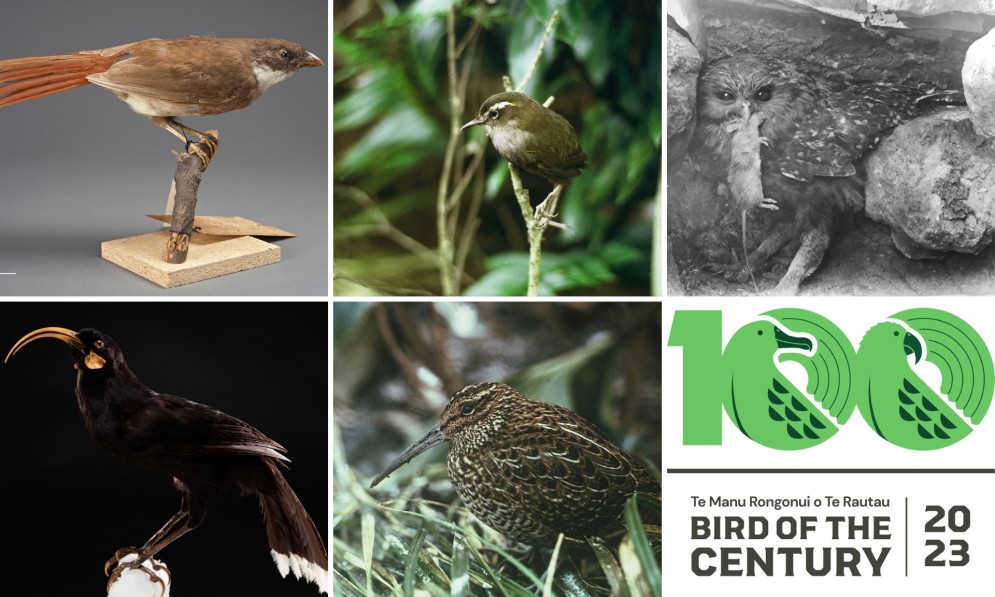Forget Bird of the Year. In 2023, the stakes are even higher.
Introducing: Bird of the Century.
The world's favourite avian election will be themed to celebrate Forest & Bird’s centenary, chief executive Nicola Toki announced this morning at the organisation’s Centennial Conference.
“This year, voters are not just electing their Bird of the Year. To celebrate our 100th birthday, we’re searching for the bird that has captured New Zealanders’ hearts over the last century,” Ms Toki says.
Seventy-five brilliant bird species are candidates in this year’s competition. This includes five extinct species added to the running for the first time ever:
-
Mātuhituhi | Bush wren – a small and nearly flightless wren that once lived on all three main islands of NZ. The last North Island bird was seen in 1955, and South Island in 1968. Birds were found on Big South Cape Island in 1964 and relocated to Kaimohu Island, where the last of them died in 1972.
-
Tutukiwi | South Island snipe – with its last refuge (Big South Cape Island) invaded by ship rats, the South Island snipe became extinct in 1964 – despite a rescue attempt mounted by the Wildlife Service. Two males were captured but died in captivity.
-
Huia – the last officially confirmed sighting of this iconic songbird was in 1907, but it’s likely the huia persisted into the 1920s. Unconfirmed but credible sightings even extend into the 50s and 60s from the Urewera Ranges.
-
Piopio – often considered the native thrush, the piopio was split into North and South Island species in 2012. But the last official records of this songster come from 1902 and 1905, with reports of sightings continuing into the 1970s.
-
Whēkau | Laughing owl – the last confirmed record of the laughing owl was a dead specimen found in Canterbury in 1914, but sight and sound records persisted into the 1930s.
“New Zealand’s extinction record is devastating. The five extinct birds in this year’s competition are a heartbreaking reminder of the incredible biodiversity we’ve lost,” says Ms Toki.
“Eighty-two percent of our living native bird species are threatened or at risk of extinction. We cannot let any more end up with the tragic fate of the laughing owl or the huia.”
All 75 contenders can be viewed on the Bird of the Year website.
Voting for Bird of the Century will open at 9am on Monday 30 October 2023 and run for two weeks, closing at 5pm on Sunday 12 November 2023. The winner will be announced the following morning on Monday 13 November 2023.
Forest & Bird invites applications for campaign managers to champion each of the 75 competitors.
You can apply to be a campaign manager here
The inaugural Bird of the Year competition took place in 2005, as a poll included in Forest & Bird’s first ever email newsletter, with the tūī taking out the title.
“In the intervening years, a simple poll has grown to become a national institution and beloved celebration of Aotearoa’s native birds,” says Ms Toki.
“We’ve had some crazy moments: voting scandals, a bat winning, a competition favourite booted for being too popular.
“We hope New Zealanders and people around the world will get involved in the fun of Bird of the Century 2023, discover the amazing stories behind our living and dearly departed feathered friends, and ultimately be inspired to speak up for them.”
Image – Top, left to right: Huia by Auckland Museum Ref LB 9129 (CC BY 4.0); North Island Piopio, Turnagra tanagra, collected 8 September 1900, Waitotara district, New Zealand. CC BY 4.0. Te Papa (OR.000212). Bottom, left to right: South Island snipe by Don Merton/Department of Conservation Ref 10040147; Laughing owl by Buthbert & Oliver Parr, 1909 at Raincliff Station, Opihi River, South Canterbury; Bush wren by Don Merton/Department of Conservation Ref 10037276.

